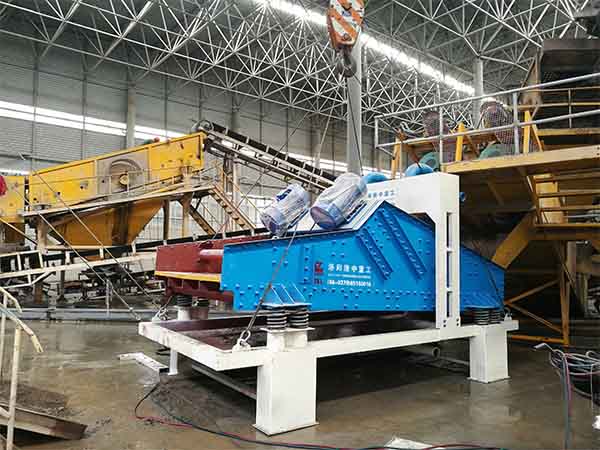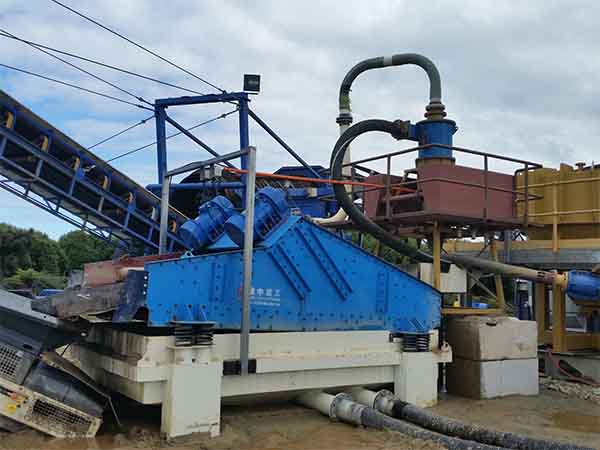How To Improve The Screening Efficiency of Linear Vibrating Screen?
The screening efficiency of the linear vibrating screen has a certain impact on the quality of the final product and the investment cost. In the production process, the factors that affect the screening efficiency of the linear vibrating screen include material properties, motion parameters, equipment performance, and daily operation and management. The following mainly describes the influence of various factors on the screening efficiency of the linear vibrating screen, and explores how to change these factors to improve the screening efficiency.
1. Material properties
The material properties that affect the screening efficiency of the linear vibrating screen are mainly reflected in the particle size, moisture, mud content, and shape of the material.
A. Particle size
The existence of “easy to sieve particles”, “difficult to sieve particles” and “obstructive particles” have a significant impact on the screening process of the linear vibrating screen. Generally, the more “easy sieve particles”, the better the screening efficiency of the linear vibrating screen. Because the “Easy Sieve Particles” easily pass through the sieve holes, the material remaining on the sieve is rapidly reduced, thereby greatly reducing the interference factors that are difficult to sieve particles through the sieve.
B. Material moisture
Material moisture mainly includes the adsorbed water widely existing in the pores and cracks of the material and external water attached to the surface of the material. When processing high-moisture materials, the screening efficiency of the linear vibrating screen can be improved by appropriately increasing the screen hole size.
C. Mud content
If the material contains agglomerated clay minerals, even if the water content of the material is very low, the screening process will be more difficult. After the clay minerals agglomerate, a large amount of adhered fine-grained materials will be mixed into the products on the screen, which will affect the screening efficiency of the linear vibrating screen. Agglomerated materials are easy to block the screen, and once blocked, it is difficult to remove the screen. It is recommended to spray water on the material, or to de-powder or de-sludge before sieving.
D. Shape of the material
The influence of particle shape on the screening efficiency of the linear vibrating screen mainly depends on the shape of the screen hole. For square or round screens, flat or rectangular materials are more difficult to screen through, while spherical, cubic, and polygonal materials can obtain better screening efficiency.
2. The motion parameters
The motion parameters that affect the screening efficiency of the linear vibrating screen mainly include the inclination angle of the screen surface, the vibration direction angle, the amplitude of the screen surface, and the vibration frequency.
A. Screen inclination
The screen inclination mainly depends on the required processing capacity and screening efficiency. After other parameters are determined, the larger the inclination angle, the higher the processing capacity, but the lower the screening efficiency. vice versa.
- For screening materials >50mm, the inclination angle of the screen is generally 5-10°.
- For screening materials <40mm, the inclination angle of the screen is generally 0°.
- For dewatering, de-intermediation, and de-sliming, and the inclination angle of the screen surface is -5-0°.
B. Vibration direction angle
In actual production, most linear vibrating screens adopt 30°, 45°, and 60° vibration direction angles, which not only can better adapt to various screening performances, but also obtain ideal moving speed and screening efficiency.
- When the vibration direction angle is 30-45°, the material movement speed is fast and the processing capacity is high, but the screening efficiency is not high. Suitable for handling materials that are easy to screen.
- When the vibration direction angle is 60°, the material ejection angle is large, the screening efficiency is high. Suitable for processing difficult-to-screen materials.
C. Screen surface amplitude
The amplitude of the linear vibrating screen is related to the size and purpose of the vibrating screen and the particle size of the processed materials. Generally, the single amplitude of linear vibrating screens is 3.5-5.5mm. The larger the size of the vibrating screen, the larger the amplitude. The linear vibrating screen is used for screening, and the amplitude needs to be slightly larger. For dehydration and desliming, the amplitude should be smaller. When the particle size of the processed material is large, the amplitude of the linear vibrating screen should be increased accordingly. On the contrary, the amplitude should be smaller.
D. Vibration frequency
The vibration frequency of the screen surface is related to the inclination angle of the screen surface, the vibration direction angle, and the amplitude of the screen surface. The vibration frequency of the linear vibrating screen is generally 700-900rpm.
3. Linear vibrating screen performance
The performance factors that affect the screening efficiency of the linear vibrating screen mainly refer to the configuration parameters of the screen surface. When the feeding amount and screening conditions are constant, the width of the linear vibrating screen’s screen surface determines the processing capacity of the linear vibrating screen, and the length of the screen determines the screening efficiency. Limited by the structure of the screen frame and the strength of the material, the width of the screen surface of the linear vibrating screen cannot be widened indefinitely, and the length cannot be lengthened arbitrarily. Generally, the preferred aspect ratio of the screen surface is 2-2.5.
4. Daily operation and management
In the daily operation process, the linear vibrating screen needs to maintain uniform, continuous and appropriate feeding, which is conducive to the penetration of fine particles, so as to obtain higher processing capacity and screening efficiency.
In daily maintenance, the operator needs to pay special attention to the tightness of the screen surface. Do a good job in the maintenance and rust prevention of the screen surface of the linear vibrating screen, clean the screen surface in time, repair and replace the damaged screen surface. In addition, the operator should do the routine maintenance work before starting, during operation, and after shutting down according to the standard. Problems and hidden dangers are found to be eliminated in time, which not only ensures the safe operation of the equipment in an intact state but also effectively controls the maintenance cost of the equipment.
Related Products
There are no relevant articles.




